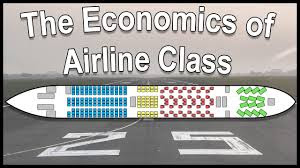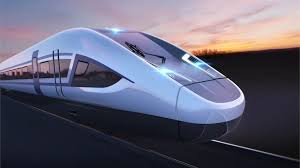I ended up talking a lot about the Concorde—the supersonic plane--but part of the story was left untold. Even though the Concorde failed, even though it wasn’t commercially viable, it still had a profound effect on how we fly today. Let me explain... Economy class is not how airlines make money. The real money, at least for the traditional airlines, is in premium cabins. Let’s take, for example, this British Airways 777. There are 224 total seats on this plane and it flies daily between London Heathrow and Washington Dulles airport. A roundtrip economy class ticket leaving March 15th and returning on March 22nd costs, at the time of writing, $876. That means that, if each one of the 122 economy class seats is filled, the entire back section of the plane will make the airline, round-trip, $106,872.
Meanwhile, the going rate for one of their premium-economy seats is $2,633 round-trip meaning the entire cabin will make $105,320. Already you can see that the entire 40 seat premium-economy section makes British Airways roughly as much as the entire economy-class section. Going up to Business Class, there are 48 seats sold each for $6,723 making the airline $322,704. The 14 first class seats are sold for $8,715 each or $122,010 total. So, once again, the 14 passengers at the front of the plane make the airline more money than the 122 at the back of the plane. In total, the three premium cabins--premium economy, business, and first—make the airline on this flight $550,034.
That means that 45% of the passengers account for 84% of the airline’s revenue! Now, I need to add some caveats. There is no airline on earth that makes half a million dollars for a six hour flight over the Atlantic. If they did, they would be swimming in money. The fares for this particular routing are significantly higher than the average fare paid for that flight because they’re non-stop fares between two high-income, high-demand cities. Of course, a majority of the passengers on that flight will not be traveling between London and Washington, they’ll have connected. If you originate the ticket in, say, Stockholm, and connect onto that 777 flight to Washington the economy class price drops to $392, the premium economy to $1,150, the business class to $3,025, and the first class to $5,564. But the proportions are still roughly the same.
A vast majority of the revenue comes from a minority of passengers. This particular British Airways 777 is also a very premium-heavy configuration because British Airways is an airline that focuses a lot on premium travel, but still, on average, 2/3 of any airlines revenue comes from passengers in First, Business, or Premium Economy class but this wasn’t always the case. In the beginning of commercial aviation, there weren’t really any classes because everythin was premium. That’s not to say that planes were very luxurious--a 1920s plane looked likethis--but flying was just so expensive that the experience of flying was the luxury itself. It’s kind of like how you don’t see Virgin Galactic selling first, business, and economy class seats on their planned tourist flights to space.
The experience itself is the luxury. Once commercial space travel becomes commonplace, we’ll almost certainly see a classification of the experience but until a transport method is at a cost where it’s attainable to the normal person, it’s all first class. In 1950 a round-trip coach fare between New York and London was $675--adjusted for inflation, thats $6,800 today--roughly the same price as a first-class ticket on the same route nowadays. It’s the exact same type of passenger flying in both these seats. What’s changed is who’s flying further back in the plane. So the story of the development of airline classes really isn’t the story of how airlines developed more and more luxurious seats, it’s how they cut costs to allow more and more people to fly. It’s also a fascinating demonstration of economics. Airlines have figured out a way to sell the same product for different prices to different people. The overall product that airlines are selling is the same no matter which class you’re flying--a flight from point a to point b. What’s different is the experience within the plane.
The first classification of air travel happened in the 40s and 50s. A significant amount of revenue for airlines at the time came from contracts for air-mail routes with the US Postal Service. These flights flew with many stops often overnight or at odd hours. While the planes mostly carried mail, they still had a passenger section. The first class fares got you, for example, on a non-stop flight between New York and Chicago while the coach fare might get you on a mail flight that left at 2am and stopped in Pittsburgh and Cleveland on the way to Chicago. While the fare was cheaper and the flight took longer, the experience onboard the plane was largely the same. It wasn’t until 1952 that airlines started selling the same flights for different prices.
One airline, for example, sold standard class one-way tickets between New York and London for $395 and tourist-class tickets for $270. It was the exact same flight on the exact same plane--the difference was in the ticket. Tourist class tickets had to be purchased in advance and had no flexibility--you had to fly on the exact flight the ticket was purchased for. As the name suggested, these tickets were primarily for tourists. Tourists plan trips far in advance and don’t really need flexibility so it was no problem for them to commit to one flight. The full-fare tickets were for the other type of traveller—the business-person. Business travelers, first off, don’t typically pay for their own tickets.
They’re paid for by their employer so they individually don’t really care what the ticket costs. Business travelers also require flexibility and generally don’t purchase tickets until the last minute. At the time, it was common practice to just walk up to the counter an hour before a flight and buy a ticket. That’s what the full-fare tickets were for. Through this system, the airlines segmented the market into two categories based on what people were willing to pay. Over the coming decades, this was the only large classification system in air travel.
Then, between 1969 and 1978 three things happened—the 747 flew for the first time, the Concorde flew for the first time and airlines were deregulated in the US. The 747 gave airlines the space to experiment with luxury, the Concorde gave them the reason to, and deregulation gave them the ability to. Previously, all airfares were heavily regulated in the US and itwas difficult for airlines to charge the cost they wanted for different classes but with deregulation airlines now had full control over their ticket prices.
Now, at the time, much of the difference was still in the ticket. Some airlines had introduced first class fares with nicer seats, but airlines realized that they had to start treating the business-people who bought a full-fare coach ticket differently than the tourists paying a discounted fare. More and more of those business travelers were just paying the tourist class fare. It began by just physically separating the passengers. The full-fare passengers would be seated up front while the discounted fare passengers would be put in the back. Then, some airlines started blocking out the middle seat next to the full-fare passengers. Finally, some airlines started to build cabins with slightly nicer seats and better amenities. But, with exceptions, airlines avoided first class. Most focused on capturing that middle tier of traveller because the Concorde was going to be the first class plane for the rich and famous--regular planes would be the business and economy class... at least that’s what they thought. Of course, as you heard about in my last video, the Concorde failed... spectacularly. Airlines avoided first class in the 70s and 80s because of the Concorde, but as they started to catch on to the failure of supersonic flight, select airlines slowly reintroduced first class to subsonic planes. But the effect is still seen today.
Of the dozens of airlines flying transatlantic, only six have a first class cabin. Back in the 60s and 70s the imminent perceived competition of the Concorde really invigorated airlines to optimize that middle class--business class—and we likely would not have seen it as early as we did without that looming disruption to the industry. But there’s another trend to explain—first class is going away... again. Let’s take a look at the seat-map of a Etihad a380. Each economy class seat on this plane takes up 3.77 square feet (0.35 m²) of floorspace, the business class seats take up 10.14 ft² (0.94 m²) of floorspace, and the first class seats take up 35 ft² of floorspace (3.25 m².) On a flight from Abu Dhabi to New York, economy class tickets are $1,253 round-trip, business class tickets are $6,140, and first class tickets are $14,128.
That means that economy class seats make $332 per square foot, business class seats $605 per square foot, and first class seats $403 per square foot. The difference between economy class and business class is huge--it’s a cramped seat versus a bed--but the difference between business class and first class is just a bit more room and some better food. It’s very hard for airlines to sell first class for much more than business class since the experience is largely the same but the cost for the airlines to run a first class cabin is significantly more. Therefore, more and more airlines are taking out their first class to just put in more business class, it just makes more money. If an airline could fill an plane full of business-class passengers it would--its been tried--but pretty much no route has the premium demand to fill a plane-full of business class.
Everyone in economy, in the end, is just there to fill the plane. This video was made possible by Squarespace. Squarespace is the absolute easiest way to make your website. I’ve used them for a few different sites including WendoverProductions.com. As I said last time, I basically bought that domain to be sure nobody else could. I didn’t really have the time or need to create a fancy website so I just spent about 15 minutes to throw together a landing page. It was incredibly easy with the squarespace templates and, in my opinion at least, it looks great. Now, I can give people one link that takes them to a page with the links to all my different social media profiles. You can create a landing page like this, a blog, a store, really anything with squarespace and what’s best is that you can get 10% off your first order by using the code “Wendover” over at Squarespace.com/Wendover.









0 Comments